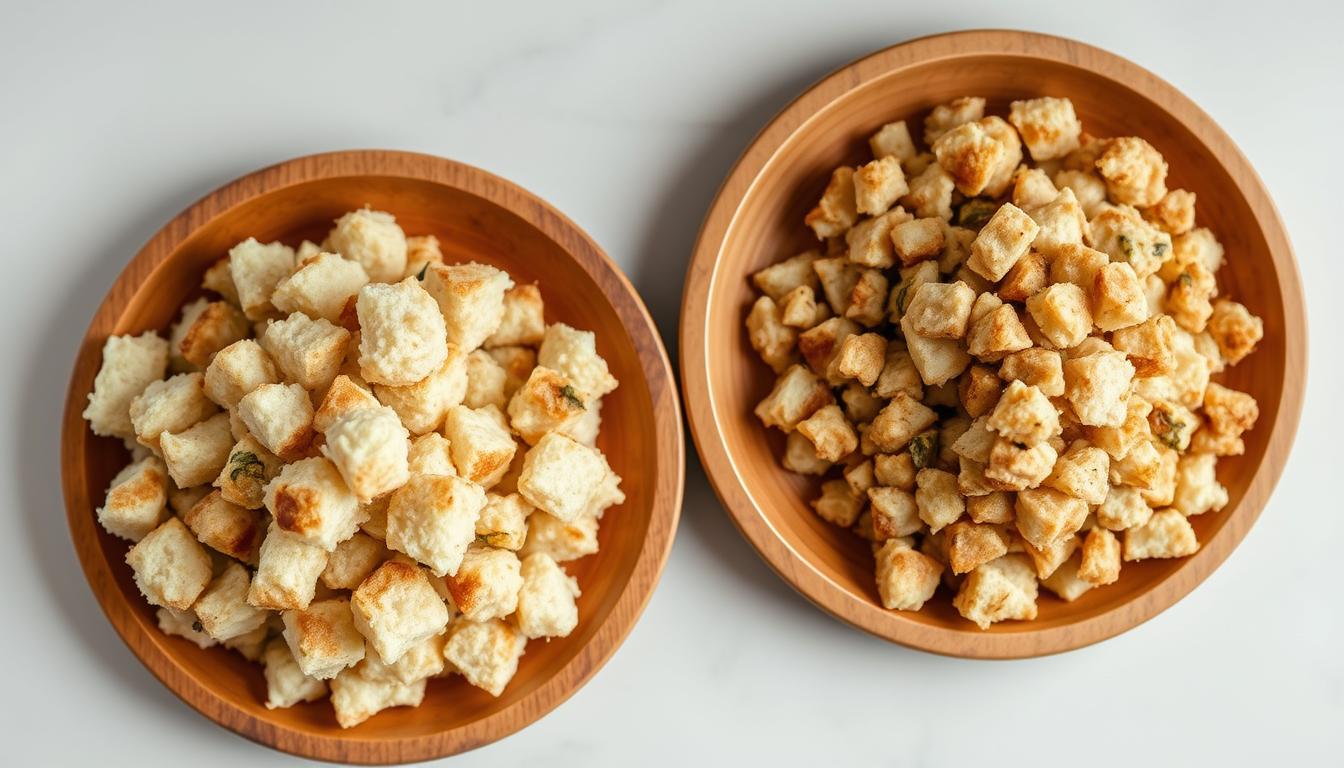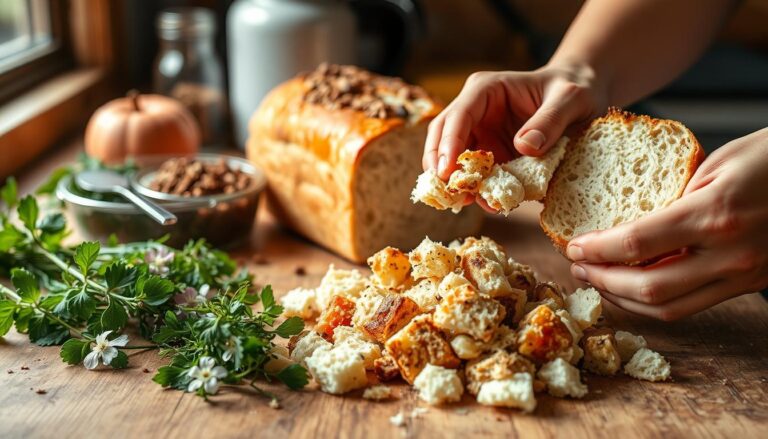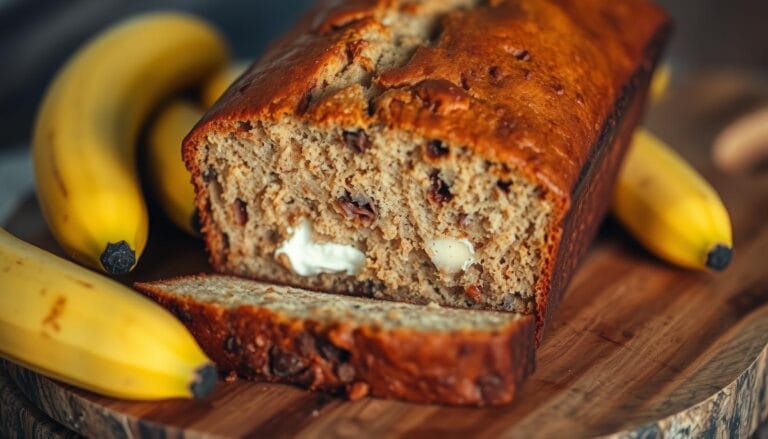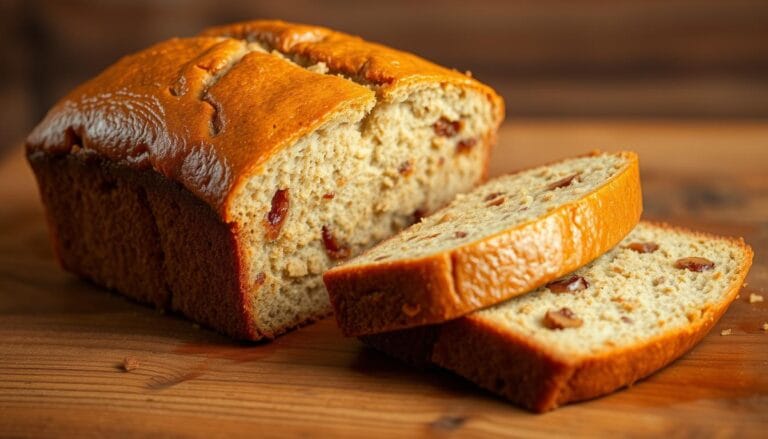Homemade Sourdough Stuffing vs. Store-Bought: Key Differences
Every Thanksgiving, I remember my grandmother’s kitchen. The warm aroma of sourdough stuffing filled the air. Her hands mixed ingredients with love and precision. Those memories sparked my journey into understanding the magic of homemade sourdough stuffing.
The stuffing can make or break a holiday meal. Choosing between homemade sourdough stuffing and store-bought is more than convenience. It’s about flavor, tradition, and making memories at the table.
Sourdough stuffing is more than a side dish. It’s a culinary art form that turns simple ingredients into something special. The fermented sourdough bread adds a unique tanginess and depth that store-bought mixes can’t match.
In this exploration, you’ll see why cooks choose homemade sourdough stuffing. We’ll look at the differences that make handcrafted versions better than mass-produced ones.
Get ready to change your holiday cooking. Learn how making homemade sourdough stuffing can make your meals unforgettable.
Table of Contents
Understanding Sourdough Bread’s Role in Stuffing
Sourdough bread makes a simple side dish into a masterpiece. It’s perfect for holiday recipes that wow your guests.
Choosing sourdough bread for stuffing means you get a special ingredient. It makes your dish better than usual.
Fermentation Benefits and Flavor Profile
The fermentation process gives sourdough a tangy taste. This adds depth to your stuffing. It makes the flavors more complex.
- Develops rich, complex flavor notes
- Provides natural tanginess
- Creates a more sophisticated taste experience
Texture and Moisture Retention Properties
Sourdough bread is great for stuffing because of its texture. It’s dense, so it holds flavors well. It stays crispy on the outside and soft on the inside.
- Absorbs liquid ingredients effectively
- Maintains structural integrity during cooking
- Creates a crispy exterior with a soft interior
Nutritional Advantages of Sourdough
Sourdough bread is not just tasty. It’s also good for you. The fermentation process makes it easier to digest.
- Lower glycemic index compared to regular bread
- Improved digestibility
- Enhanced nutrient absorption
Choosing sourdough bread for stuffing is not just a culinary choice, but a nutritional upgrade to your favorite holiday dish.
Essential Ingredients for Homemade Sourdough Stuffing
Making the perfect homemade sourdough stuffing starts with picking top-notch ingredients. These ingredients should bring out rich, complex flavors. Your stuffing will be unforgettable if you choose each part carefully.
The base of a great homemade sourdough stuffing is the sourdough bread. Use a day-old or slightly stale loaf. It should have deep, tangy flavors and soak up the other ingredients well.
- Sourdough bread (day-old and cubed)
- Unsalted butter for richness
- Fresh aromatic vegetables:
- Onions
- Celery
- Garlic
- Fresh herbs for depth of flavor:
- Parsley
- Sage
- Rosemary
- High-quality chicken or vegetable broth
- Large eggs for binding
Choose fresh and high-quality ingredients for your homemade sourdough stuffing. The sourdough bread should taste robust. Herbs should be fresh and fragrant.
| Ingredient | Purpose | Recommended Quantity |
|---|---|---|
| Sourdough Bread | Base and texture | 8-10 cups cubed |
| Butter | Richness and moisture | 1/2 cup |
| Chicken Broth | Moisture and flavor | 2-3 cups |
| Eggs | Binding | 2 large eggs |
You can make your homemade sourdough stuffing your own by changing herbs or adding special ingredients. Just remember to keep the balance. This way, the sourdough’s unique tangy taste will shine through.
Store-Bought Stuffing Mix Analysis
Finding the right store-bought sourdough stuffing can be tough. Home cooks want something easy but still good. Pre-made mixes are quick for holidays, but they have downsides.
When looking at store-bought sourdough stuffing, pay attention to these points:
Popular Brand Comparisons
- Pepperidge Farm Classic Herb Stuffing
- Kraft Stove Top Traditional Stuffing
- Mrs. Cubbison’s Seasoned Stuffing Mix
Ingredient Quality Assessment
Most mixes have:
- Processed bread cubes
- High sodium content
- Artificial preservatives
- Synthetic flavor enhancers
“Not all stuffing mixes are created equal” – Culinary Expert
Price Point Considerations
For those watching their budget, store-bought stuffing is cheap. Prices are $2.50 to $4.99 per package. This makes them a good choice for fast meals.
But, these mixes don’t have the taste and health of homemade. Think about how much time you save versus the flavor you get.
The Art of Making Homemade Sourdough Stuffing
Can you make stuffing with sourdough bread? Yes, you can! Making homemade sourdough stuffing is quite simple. The secret is choosing the right sourdough bread and preparing it well.
To start, cut your sourdough bread into one-inch cubes. Drying the bread is key for the right texture. You can dry it in two ways:
- Leave bread cubes out overnight on a baking sheet to air dry
- Bake cubes in the oven at 300°F for about 35 minutes
Then, add layers of flavor. Sauté onions and celery in butter until they’re soft. Add fresh herbs like sage, thyme, and parsley for extra taste.
“The secret to amazing stuffing is using high-quality, flavorful sourdough bread and fresh ingredients.” – Professional Chef
Mix your dried bread cubes with the sautéed veggies and herbs. Add chicken or vegetable broth and beaten eggs to hold it all together. The sourdough bread’s tangy taste will make your stuffing special.
Pro tip: Don’t overdo it with the liquid. Add it slowly to keep the bread just right.
Time and Effort Comparison
Making homemade sourdough stuffing needs careful planning. It’s key to know how to prepare it well. This makes your holiday meal prep easier.
Preparation Requirements
Homemade sourdough stuffing has its own steps. It’s different from store-bought mixes. Here’s what you need to do:
- Cubing homemade sourdough bread
- Selecting fresh herbs and seasonings
- Chopping vegetables
- Mixing ingredients carefully
Storage and Make-Ahead Options
Homemade sourdough stuffing is great for making ahead. You can make it up to two days before. Just keep it covered in the fridge.
| Storage Method | Duration | Recommended Action |
|---|---|---|
| Refrigerated (Unbaked) | Up to 48 hours | Cover tightly with aluminum foil |
| Baked | 3-4 days | Store in airtight container |
Cost Analysis
Homemade sourdough stuffing might cost more at first. But it’s worth it. You get better taste and health benefits.
- Ingredient costs: Slightly higher than boxed mixes
- Quality control: Complete oversight of ingredients
- Flavor profile: Substantially more complex and rich
Knowing how to prepare homemade sourdough stuffing makes it special. It turns a simple side dish into a memorable meal.
Flavor Profiles and Texture Differences

Your sourdough stuffing turns the usual holiday side dish into a true masterpiece. The sourdough bread’s unique fermentation gives it a flavor depth that store-bought mixes can’t match. When you make sourdough stuffing, you’ll see a big difference in taste and texture right away.
The magic of sourdough stuffing is its complex flavor. Sourdough bread adds a tangy taste that balances out the rich ingredients. This tanginess comes from the fermentation process, making the flavor deeper and more complex than regular bread stuffing.
- Texture: Crispy outside with a soft, moist inside
- Flavor: Tangy notes with a rich, savory taste
- Complexity: A layered taste experience
Texture is key in great sourdough stuffing. The bread’s strong structure holds onto moisture but stays crispy. This makes every bite a perfect mix of crunchy and soft.
The secret to outstanding sourdough stuffing is letting the bread fully develop its flavor before mixing with other ingredients.
Professional chefs love sourdough stuffing for its ability to make traditional recipes better. The bread’s natural complexity means you can use fewer seasonings. This creates a dish that will wow your dinner guests.
Customization Options and Creative Variations
Make your boudin sourdough stuffing recipe special by trying new things. Homemade stuffing is very flexible. You can make it your own, showing off your cooking style.
Your boudin sourdough stuffing recipe is like a blank canvas. You can add many tasty ingredients and flavors to it.
Herb and Spice Combinations
Boost your stuffing’s taste with these great herb and spice mixes:
- Classic Thanksgiving: Sage, thyme, and rosemary
- Mediterranean Twist: Oregano, basil, and marjoram
- Cajun-Inspired: Cayenne, paprika, and dried parsley
- Rustic French: Tarragon, chervil, and herbes de Provence
Exciting Add-In Possibilities
Make your boudin sourdough stuffing recipe even better by adding these tasty things:
- Protein Boosters:
- Spicy boudin sausage
- Crispy bacon bits
- Roasted chicken chunks
- Vegetable Enhancements:
- Caramelized onions
- Roasted mushrooms
- Sautéed celery
- Textural Surprises:
- Toasted pecans
- Dried cranberries
- Chopped apple
“The secret to an unforgettable stuffing is not just following a recipe, but making it your own.” – Chef’s Wisdom
Remember, your boudin sourdough stuffing recipe is a journey. Feel free to try new things and make a dish that shows who you are.
Health and Dietary Considerations

Sourdough bread for stuffing has special health benefits. It’s made through a process that makes it easier to digest and full of nutrients. This makes it a great choice for your holiday side dish.
Those with mild gluten sensitivities might find sourdough bread easier to digest. The long fermentation breaks down gluten. This makes it more tolerable for those with digestive issues. The nutritional benefits include:
- Lower glycemic index compared to regular bread
- Enhanced nutrient absorption
- Increased probiotic content
- Reduced phytic acid levels
When making sourdough bread for stuffing, you can adjust it to fit different diets. Here are some tips:
- Gluten-free option: Use certified gluten-free sourdough starter and bread
- Vegan variation: Replace animal-based ingredients with plant-based alternatives
- Low-sodium version: Control salt content by selecting ingredients carefully
Homemade sourdough stuffing lets you choose the ingredients and how much you use. By picking fresh, organic ingredients, you make a healthier option. You also get better flavor and more nutrients.
Storage and Reheating Methods
Keeping your homemade sourdough stuffing tasty and fresh is key. You can enjoy it for days after making it. Just follow some simple steps.
Refrigeration Strategies
Here’s how to store your sourdough stuffing right:
- Cool the stuffing completely before storing
- Use airtight containers to prevent moisture loss
- Refrigerate within two hours of cooking
- Store for maximum 3-4 days in the refrigerator
Reheating Your Stuffing
Make your sourdough stuffing warm again with these tips:
- Oven Method: Preheat to 350°F, cover with foil, and heat for 15-20 minutes
- Microwave Method: Heat in short intervals, stirring between each to ensure even warming
- Add a splash of broth to maintain moisture during reheating
Freezing Options
Freezing is great for keeping your stuffing fresh longer. Wrap it tightly in freezer-safe containers or bags. This way, it can last up to a month.
Pro tip: Label your storage container with the date to track freshness!
Conclusion
Making homemade sourdough stuffing makes your holiday meal special. You learn about sourdough’s unique qualities. This lets you make a side dish that’s more than just a recipe.
The flavor, texture, and health benefits of sourdough stuffing make it a great choice. It’s perfect for any big event.
Preparing sourdough stuffing lets you try new things. You can add herbs, spices, and more to match your taste. Unlike store-bought mixes, you control the quality and taste.
By making your own sourdough stuffing, you create a special moment. This article gives you the tools to make a gourmet dish. It will wow your guests and might start a new tradition.
Your kitchen is ready to make your holiday meals better. Whether you’re experienced or just starting, sourdough stuffing is a chance to show off your skills. It’s a way to share your love for great food.
FAQ
Can I make stuffing with sourdough bread?
Yes, you can! Sourdough bread is perfect for stuffing. It has a tangy taste and a thick texture. This makes it great for soaking up flavors.The way sourdough is made adds depth to your stuffing. It’s much better than regular bread.
What makes sourdough stuffing different from regular stuffing?
Sourdough stuffing tastes more complex than regular stuffing. Its tangy flavor adds a special touch. The bread’s denser texture also helps keep the stuffing moist and flavorful.
Is homemade sourdough stuffing healthier than store-bought mixes?
Usually, yes. Making your own stuffing lets you pick the ingredients. This means less bad stuff and less salt. Sourdough bread is also better for you, being easier to digest and less likely to raise blood sugar.You can make it even healthier by adding fresh herbs and veggies.
How do I prevent my sourdough stuffing from becoming too dry?
To avoid dry stuffing, use a few tricks. Start with day-old sourdough bread that’s been dried or toasted lightly. This helps it soak up moisture without getting soggy.When mixing, add just the right amount of liquid. Use chicken or veg broth. Cover the stuffing while it bakes. If it looks too dry, add a bit more liquid.
Can I make sourdough stuffing ahead of time?
Yes, you can make it ahead. Prepare it 1-2 days before and keep it in the fridge. Reheat it in the oven, covered, to keep it moist.If you freeze it, thaw it in the fridge before baking. This saves a lot of time during holidays.
What are some creative add-ins for sourdough stuffing?
There are many tasty add-ins for sourdough stuffing. Try boudin sausage for a Cajun flavor, wild mushrooms for earthiness, or toasted pecans for crunch.Dried cranberries add sweetness, and diced apples bring freshness. Herbs like sage, thyme, and rosemary add depth and complexity.
How can I make my sourdough stuffing vegetarian or gluten-free?
For a veggie version, use veg broth instead of meat broth. Omit any meat. For gluten-free, use gluten-free sourdough or bread cubes.Make sure all ingredients are gluten-free. Be careful not to mix gluten-free with gluten. Keep the herbs and spices the same for great flavor.







